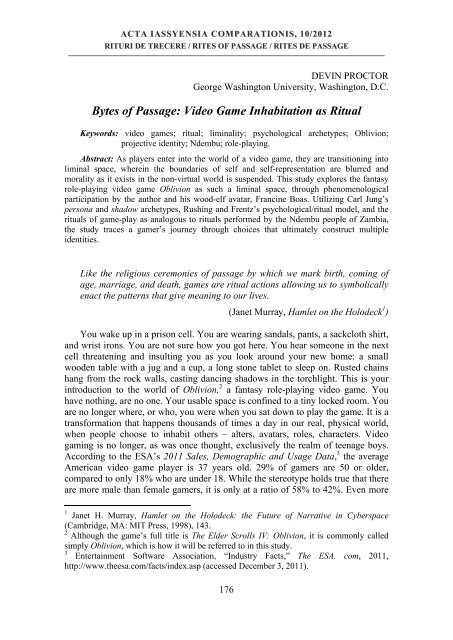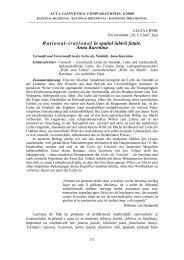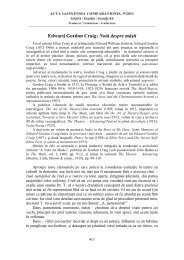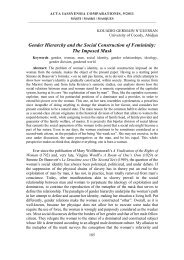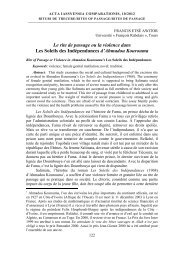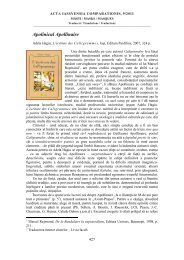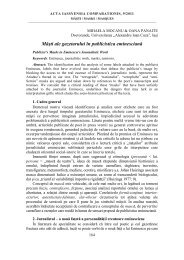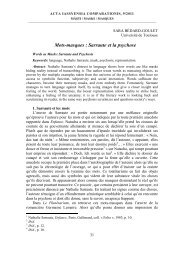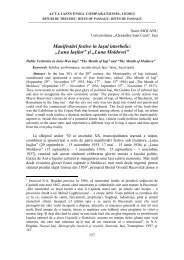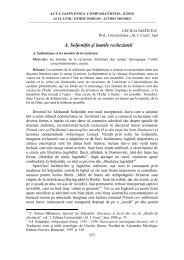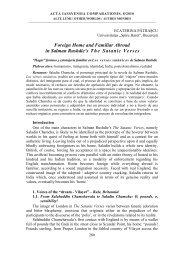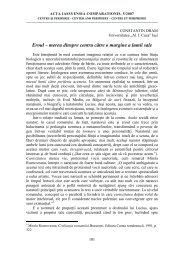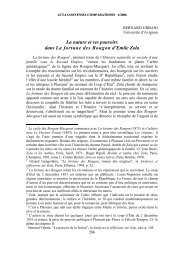Bytes of Passage: Video Game Inhabitation as Ritual
Bytes of Passage: Video Game Inhabitation as Ritual
Bytes of Passage: Video Game Inhabitation as Ritual
Create successful ePaper yourself
Turn your PDF publications into a flip-book with our unique Google optimized e-Paper software.
ACTA IASSYENSIA COMPARATIONIS, 10/2012<br />
RITURI DE TRECERE / RITES OF PASSAGE / RITES DE PASSAGE<br />
________________________________________________________________________________<br />
DEVIN PROCTOR<br />
George W<strong>as</strong>hington University, W<strong>as</strong>hington, D.C.<br />
<strong>Bytes</strong> <strong>of</strong> <strong>P<strong>as</strong>sage</strong>: <strong>Video</strong> <strong>Game</strong> <strong>Inhabitation</strong> <strong>as</strong> <strong>Ritual</strong><br />
Keywords: video games; ritual; liminality; psychological archetypes; Oblivion;<br />
projective identity; Ndembu; role-playing.<br />
Abstract: As players enter into the world <strong>of</strong> a video game, they are transitioning into<br />
liminal space, wherein the boundaries <strong>of</strong> self and self-representation are blurred and<br />
morality <strong>as</strong> it exists in the non-virtual world is suspended. This study explores the fant<strong>as</strong>y<br />
role-playing video game Oblivion <strong>as</strong> such a liminal space, through phenomenological<br />
participation by the author and his wood-elf avatar, Francine Bo<strong>as</strong>. Utilizing Carl Jung’s<br />
persona and shadow archetypes, Rushing and Frentz’s psychological/ritual model, and the<br />
rituals <strong>of</strong> game-play <strong>as</strong> analogous to rituals performed by the Ndembu people <strong>of</strong> Zambia,<br />
the study traces a gamer’s journey through choices that ultimately construct multiple<br />
identities.<br />
Like the religious ceremonies <strong>of</strong> p<strong>as</strong>sage by which we mark birth, coming <strong>of</strong><br />
age, marriage, and death, games are ritual actions allowing us to symbolically<br />
enact the patterns that give meaning to our lives.<br />
(Janet Murray, Hamlet on the Holodeck 1 )<br />
You wake up in a prison cell. You are wearing sandals, pants, a sackcloth shirt,<br />
and wrist irons. You are not sure how you got here. You hear someone in the next<br />
cell threatening and insulting you <strong>as</strong> you look around your new home: a small<br />
wooden table with a jug and a cup, a long stone tablet to sleep on. Rusted chains<br />
hang from the rock walls, c<strong>as</strong>ting dancing shadows in the torchlight. This is your<br />
introduction to the world <strong>of</strong> Oblivion, 2 a fant<strong>as</strong>y role-playing video game. You<br />
have nothing, are no one. Your usable space is confined to a tiny locked room. You<br />
are no longer where, or who, you were when you sat down to play the game. It is a<br />
transformation that happens thousands <strong>of</strong> times a day in our real, physical world,<br />
when people choose to inhabit others – alters, avatars, roles, characters. <strong>Video</strong><br />
gaming is no longer, <strong>as</strong> w<strong>as</strong> once thought, exclusively the realm <strong>of</strong> teenage boys.<br />
According to the ESA’s 2011 Sales, Demographic and Usage Data, 3 the average<br />
American video game player is 37 years old. 29% <strong>of</strong> gamers are 50 or older,<br />
compared to only 18% who are under 18. While the stereotype holds true that there<br />
are more male than female gamers, it is only at a ratio <strong>of</strong> 58% to 42%. Even more<br />
1 Janet H. Murray, Hamlet on the Holodeck: the Future <strong>of</strong> Narrative in Cyberspace<br />
(Cambridge, MA: MIT Press, 1998), 143.<br />
2 Although the game’s full title is The Elder Scrolls IV: Oblivion, it is commonly called<br />
simply Oblivion, which is how it will be referred to in this study.<br />
3 Entertainment S<strong>of</strong>tware Association, “Industry Facts,” The ESA. com, 2011,<br />
http://www.theesa.com/facts/index.<strong>as</strong>p (accessed December 3, 2011).<br />
176
ACTA IASSYENSIA COMPARATIONIS, 10/2012<br />
RITURI DE TRECERE / RITES OF PASSAGE / RITES DE PASSAGE<br />
________________________________________________________________________________<br />
telling is how prevalent games are: 72% <strong>of</strong> American households contain video<br />
game players. This can help account for the fact that the gaming industry brought<br />
in $25.9 billion in 2010. 4 <strong>Video</strong> games are not ‘just games,’ they are aggressively<br />
perv<strong>as</strong>ive elements taking up more and more <strong>of</strong> America’s leisure time.<br />
<strong>Video</strong> <strong>Game</strong>s <strong>as</strong> Liminal Space<br />
The concept <strong>of</strong> liminality comes from the Latin limen, meaning ‘threshold.’ 5<br />
Liminal space is “betwixt and between the positions <strong>as</strong>signed and arrayed” 6 by the<br />
laws and conventions <strong>of</strong> larger society. In liminal space, morality, social standing,<br />
and rational decision-making are suspended. As an anthropological construct,<br />
liminality w<strong>as</strong> introduced in Arnold ven Gennep’s ethnographic work concerning<br />
ritual practice, The Rites <strong>of</strong> <strong>P<strong>as</strong>sage</strong>. Van Gennep divides ritual into three ph<strong>as</strong>es,<br />
“preliminal rites (rites <strong>of</strong> separation), liminal rites (rites <strong>of</strong> transition), and<br />
postliminal rites (rites <strong>of</strong> incorporation).” 7 In the separation ph<strong>as</strong>e, a person is<br />
moved outside <strong>of</strong> the normal modes <strong>of</strong> society and behavior. This <strong>of</strong>ten involves a<br />
change in location or appearance to establish a separate identity. The transition<br />
ph<strong>as</strong>e includes the actual liminal space, a “period <strong>of</strong> ambiguity, a sort <strong>of</strong> social<br />
limbo.” 8 Categories <strong>of</strong> understanding and symbols <strong>of</strong> meaning are no longer<br />
<strong>as</strong>sumed. Everything must be tested and proven. Rules are rewritten. The people<br />
involved in this ph<strong>as</strong>e rebuild previous notions and face truths about the way they<br />
had constructed their reality. The third ph<strong>as</strong>e, that <strong>of</strong> incorporation, involves the<br />
person returning to society with renewed understanding <strong>of</strong> his or her place within<br />
it. Having been separated and forced to confront truths about him or herself, the<br />
person is allowed to rejoin the community <strong>as</strong> a full member.<br />
Victor Turner builds on these concepts with the notion <strong>of</strong> the “liminal<br />
personae” or “threshold people.” 9 When involved in ritual, those who inhabit the<br />
liminal space must be “represented <strong>as</strong> possessing nothing” and therefore may “wear<br />
only a strip <strong>of</strong> clothing, or even go naked, to demonstrate that <strong>as</strong> liminal beings<br />
they have no status.” 10 In liminal space, all who exist are blank slates, so they may<br />
adopt the identity and properties the ritual bestows on them. The deconstruction <strong>of</strong><br />
all other symbols from the outside world – including normal clothing, title, even<br />
names – serves to create an environment <strong>of</strong> transparency and truth. All knowledge<br />
created within liminal space comes from core understandings that do not rest on<br />
semiotic readings <strong>of</strong> our comfortable and constructed culture.<br />
4<br />
Ibid.<br />
5<br />
Victor Turner, The <strong>Ritual</strong> Process: Structure and Anti-Structure (New Brunswick: Aldine<br />
Transaction, 1969), 95.<br />
6<br />
Ibid.<br />
7<br />
Arnold Van Gennep, The Rites <strong>of</strong> <strong>P<strong>as</strong>sage</strong>, trans. Monika B. Vizedom and Gabrielle L.<br />
Caffee (Chicago: University <strong>of</strong> Chicago Press, 1960), 11.<br />
8<br />
Victor Turner, From <strong>Ritual</strong> to Theatre: The Human Seriousness <strong>of</strong> Play (New York: PAJ<br />
Publications, 1982), 24.<br />
9<br />
Turner, The <strong>Ritual</strong> Process, 95.<br />
10 Ibid.<br />
177
ACTA IASSYENSIA COMPARATIONIS, 10/2012<br />
RITURI DE TRECERE / RITES OF PASSAGE / RITES DE PASSAGE<br />
________________________________________________________________________________<br />
Author and technology scholar Janet Murray h<strong>as</strong> stated that, “In psychological<br />
terms, computers are liminal objects, located on the threshold between external<br />
reality and our own minds.” 11 When we enter into the world <strong>of</strong> the video game we<br />
exist, much like the computer that powers it, on this threshold. We change our<br />
appearance by inhabiting and controlling an avatar that usually begins <strong>as</strong> a blank<br />
slate. Often, the avatar possesses little or nothing at the onset <strong>of</strong> a game. We must<br />
not <strong>as</strong>sume the in-game world follows the same rules <strong>as</strong> outside reality. Often, the<br />
player must establish his or her new in-game identity (Turner’s liminal personae),<br />
through literally naming the character, or by completing a ‘tutorial.’ These tutorials<br />
exist in virtually every game and consist <strong>of</strong> small objectives that help the player<br />
learn how to use the interface, e.g. how to move, activate certain tools or weapons,<br />
and interact with other characters. Once identity is established, the world and its<br />
rules and behaviors must be explored and understood. As the game progresses, the<br />
player gains a firmer understanding <strong>of</strong> his or her place within the game space and is<br />
rewarded with new abilities or more tools. In this way, the game acts <strong>as</strong> a liminal<br />
space in which the concepts <strong>of</strong> identity and world understanding can be stripped<br />
and reconstructed.<br />
The Psychological/ <strong>Ritual</strong> Model<br />
Communications scholars Janice Rushing and Thom<strong>as</strong> Frentz examine internal<br />
identity in film using a tripartite model <strong>of</strong> psychological processing and change<br />
they call the Psychological/<strong>Ritual</strong> Model. B<strong>as</strong>ed primarily on a Jungian<br />
understanding <strong>of</strong> the human psyche, the first <strong>as</strong>pect <strong>of</strong> the model relies heavily on<br />
the unconscious archetypes <strong>of</strong> the persona and the shadow. The persona, can be<br />
seen <strong>as</strong> “a sort <strong>of</strong> “dressing” for the ego-the conscious, intentional part <strong>of</strong> the<br />
person.” 12 Not so simply put, it “feigns individuality, making others and oneself<br />
believe that one is an individual… it is a compromise between an individual and<br />
society <strong>as</strong> to what a man should appear to be.” 13 This is the part <strong>of</strong> ourselves that<br />
we present to the world, whether or not it is a genuine representation <strong>of</strong> our core<br />
personality. In order to exist in polite society, it is implicitly understood that we<br />
must lie every so <strong>of</strong>ten, so <strong>as</strong> not to betray the seamier sides <strong>of</strong> ourselves. This<br />
perhaps more sordid side <strong>of</strong> Self is represented in the shadow, the “dark, other Self<br />
which exists in each one <strong>of</strong> us: it is the dreadful and evil person that we might have<br />
been had we not been so careful to put <strong>as</strong>ide all the tendencies within us <strong>of</strong> which<br />
we do not approve.” 14 As “evil” and “dreadful” <strong>as</strong> the shadow seems to be, it is<br />
intrinsically a part <strong>of</strong> us, a diametric foil to our well-cultivated persona. Although<br />
understood <strong>as</strong> a source <strong>of</strong> powerful strength, the shadow consumes and warps the<br />
11<br />
Janet H. Murray, op.cit., 99.<br />
12<br />
Janice Hocker Rushing and Thom<strong>as</strong> S. Frentz, “"The Deer Hunter": Rhetoric <strong>of</strong> the<br />
Warrior,” The Quarterly Journal <strong>of</strong> Speech, no. 66 (1980): 394.<br />
13<br />
Carl Gustav Jung, The Portable Jung, ed. Joseph Campbell (New York : Viking Press,<br />
1971), 105-106.<br />
14<br />
David Cox, Modern Psychology: the Teachings <strong>of</strong> Carl Gustav Jung (New York: Barnes<br />
& Noble, 1968). Qtd in Rushing.<br />
178
ACTA IASSYENSIA COMPARATIONIS, 10/2012<br />
RITURI DE TRECERE / RITES OF PASSAGE / RITES DE PASSAGE<br />
________________________________________________________________________________<br />
psyche if given too much sway. It could be though <strong>of</strong> <strong>as</strong> Id, if Id had an antisocial<br />
disorder.<br />
The second <strong>as</strong>pect <strong>of</strong> the Psychological/<strong>Ritual</strong> model is that <strong>of</strong> the ritual. In this<br />
model, ritual is understood to be the process by which the aforementioned<br />
archetypes <strong>of</strong> Self are managed, and can take two forms: the partial and the holistic.<br />
Partial ritual is enacted to manage the persona. Partial rituals “reaffirm culturally<br />
specified values and, if successfully experienced, lead to a strengthened persona.” 15<br />
Partial rituals are conducted regularly and are <strong>of</strong>ten enacted in groups <strong>as</strong> social<br />
interaction. Holistic rituals, however, involve complete metaphorical rebirth.<br />
Holistic rituals are referred to <strong>as</strong> such because they involve the whole <strong>of</strong> the psyche<br />
– a confluence <strong>of</strong> archetypes wherein decisions are made concerning morality and<br />
the actor “faces his own shadow figure.” 16 A person is forced to confront his or her<br />
inner moral paradoxes and make choices concerning how to deal with them.<br />
Holistic rituals are enacted less <strong>of</strong>ten, and can bring about great change.<br />
The third facet <strong>of</strong> the model is that very change. When a ritual takes place<br />
(particularly if it is holistic) the psyche is in a state <strong>of</strong> confusion. The recognition <strong>of</strong><br />
the shadow, in all its moral inferiority, <strong>as</strong> a “part <strong>of</strong> one’s Self creates<br />
disequilibrium… and requires its <strong>as</strong>similation into the consciousness—the result<br />
being an altered personality.” 17 The fact that the shadow h<strong>as</strong> been accepted <strong>as</strong> an<br />
existing <strong>as</strong>pect <strong>of</strong> the Self means that a part <strong>of</strong> the shadow must be incorporated<br />
into the notion <strong>of</strong> Self. Jung posits that this can happen in one <strong>of</strong> four ways:<br />
acceptance, rejection, identification, or individuation. 18 If a person accepts the<br />
unconscious shadow, he or she comes out <strong>of</strong> the ritual eccentric or childlike, having<br />
been broken by the experience <strong>of</strong> truly seeing his or her own dark underbelly.<br />
Rejection involves the “regressive restoration <strong>of</strong> the persona,” 19 and changes the<br />
public Self very little. There is no risk involved in this outcome, but it also renders<br />
the ritual a useless exercise. The person could identify with the unconscious,<br />
causing an inversion <strong>of</strong> personality, wherein “the shadow becomes the face the<br />
person presents to the world and his previous persona becomes the repressed<br />
shadow.” 20 Jung would describe this person <strong>as</strong> schizophrenic, having attained the<br />
“knowledge <strong>of</strong> the universal collective psyche, particularly the knowledge <strong>of</strong> good<br />
and evil.” 21 People who have attained this knowledge cannot successfully wield the<br />
power it brings, and through misuse they destroy themselves. Individuation is the<br />
outcome that Jung, Rushing, and Frentz find the most favorable. The person<br />
recognizes and accepts both his or her uniqueness <strong>as</strong> well <strong>as</strong> the shared collective<br />
properties found within, shadow and all, without being consumed by it. Jung<br />
describes this person <strong>as</strong> someone who h<strong>as</strong> “purposely expose themselves to the<br />
15<br />
Rushing, Frentz, The Deer Hunter, 395.<br />
16<br />
Ibid. Italics added.<br />
17<br />
Ibid.<br />
18<br />
Jung, op.cit., 116.<br />
19<br />
Ibid.<br />
20<br />
Rushing, Frentz, op.cit., 396.<br />
21 Ibid.<br />
179
ACTA IASSYENSIA COMPARATIONIS, 10/2012<br />
RITURI DE TRECERE / RITES OF PASSAGE / RITES DE PASSAGE<br />
________________________________________________________________________________<br />
danger <strong>of</strong> being devoured by the monster… but subdued it, not once but many<br />
times.” 22 Jung contends that heroes choose this path when tested, and that a strong<br />
initial persona is required to enact this type <strong>of</strong> change.<br />
Project<br />
If liminality is achieved through ritual practice, and game space is liminal<br />
space, then gaming can be approached <strong>as</strong> ritual. It follows the same b<strong>as</strong>ic tenets <strong>of</strong><br />
separation, transition and incorporation in that we enter the world <strong>of</strong> a game by<br />
changing forms and location (non-virtual to virtual), we learn the rules <strong>of</strong> a new<br />
paradigm, where outside realities are suspended, and we leave the game space<br />
having learned new truths about the way we fit in the world. Our projective identity<br />
within this liminal space can be seen <strong>as</strong> a mimetic relationship to an avatar. We are<br />
not the avatars, but we are controlling and inhabiting the avatars, so are also not not<br />
the avatars. Through examination <strong>of</strong> game-play, this study will demonstrate that,<br />
while in our inherently mimetic projective identity, we enact both partial and<br />
holistic rituals in game space, interacting between persona and shadow, and that,<br />
when we incorporate back into non-virtual space, we bring with us residual identity<br />
change <strong>as</strong> a result.<br />
Oblivion<br />
The world <strong>of</strong> Oblivion is, by video gaming standards, m<strong>as</strong>sive. Unlike many<br />
other games, the player may choose to complete the ‘main quest,’ which contains<br />
the major intended narrative arch <strong>of</strong> the game, and is the only way to ‘win’ the<br />
game, or the player may choose to simply explore and take advantage <strong>of</strong> the over<br />
200 quests that are available within the game. Along with these quests, there are<br />
opportunities to join guilds and factions, to learn alchemy and magical enchanting,<br />
and to hunt the many species <strong>of</strong> plant and animal that live in this virtual world.<br />
Most players choose to do a mixture <strong>of</strong> all <strong>of</strong> these things. If the player is interested<br />
in learning the history <strong>of</strong> Tamriel, (the world in which Oblivion and with the other<br />
Elder Scrolls games are b<strong>as</strong>ed) he or she can read the books that are found on<br />
bookshelves throughout the homes, c<strong>as</strong>tles, forts, caves, ruins, and encampments<br />
which are among the 369 listed ‘places’ in the game. 23 To complete the game’s<br />
quests by themselves without taking time to explore would take over 100 hours; 24<br />
however, online comments and player chat rooms reveal that many spend over 400<br />
hours in the game.<br />
The Preliminal Ph<strong>as</strong>e<br />
When I begin my Oblivion experience, I have to choose a character. Most<br />
games have the player inhabit the body <strong>of</strong> a predetermined avatar (usually a white<br />
22<br />
Jung, op.cit., 119.<br />
23<br />
The number 369 excludes all expansion packs to the original game, which would bring<br />
the number to 419.<br />
24<br />
UESPWiki, Oblivion:Oblivion, http://www.uesp.net/wiki/Oblivion:Oblivion (accessed<br />
December 1, 2011).<br />
180
ACTA IASSYENSIA COMPARATIONIS, 10/2012<br />
RITURI DE TRECERE / RITES OF PASSAGE / RITES DE PASSAGE<br />
________________________________________________________________________________<br />
male), in order to serve the prewritten narrative <strong>of</strong> the game. Oblivion, however,<br />
along with an incre<strong>as</strong>ing number <strong>of</strong> role-playing games, allows players to choose<br />
their avatar’s name, race, gender, skills, birth sign, and even design in detail how<br />
their avatar will look. I choose a female wood elf, painstakingly design her face,<br />
and name her Francine Bo<strong>as</strong>, in honor <strong>of</strong> the project. As for her skills and birth<br />
sign, I choose thief and <strong>as</strong>s<strong>as</strong>sin-related skills like sneak, marksman, security,<br />
alchemy, blade, and light armor. I choose these because I want to play the game <strong>as</strong><br />
a sneaky ninja-type character, hiding in the shadows and sniping, or picking<br />
pockets and breaking into safes. In this way I am changing my identity to that <strong>of</strong><br />
Francine Bo<strong>as</strong>, for a time. This management <strong>of</strong> specific terms and attributes used to<br />
construct identity can be seen <strong>as</strong> a type <strong>of</strong> birth, <strong>as</strong> well <strong>as</strong> a naming ceremony,<br />
both <strong>of</strong> which are considered by van Gennep to be rites <strong>of</strong> preliminal separation. 25<br />
When I have fully created my character, the screen instantly switches to a first<br />
person view <strong>of</strong> the prison described at the beginning <strong>of</strong> this paper. I, the non-virtual<br />
player, am seeing this for the first time through the eyes <strong>of</strong> Francine, the virtual<br />
avatar, who is also seeing it for the first time. We are both experiencing this<br />
together at her moment <strong>of</strong> birth, and thus our shared identity is created. A tutorial<br />
begins and informs us how to move around the cell. 26 As we learn together, the<br />
projective identity strengthens. After a few minutes, the intended narrative arch <strong>of</strong><br />
the game begins with the Emperor, Uriel Septim, 27 coming into the cell with his<br />
guards. He tells Francine and I that we shouldn’t be here; this is the p<strong>as</strong>sage to the<br />
escape route he is using to run from an <strong>as</strong>s<strong>as</strong>sination attempt. As the guards open<br />
up the secret back wall <strong>of</strong> the cell, the Emperor says to us, “Perhaps the Gods have<br />
placed you here so that we may meet. As for what you have done... it does not<br />
matter. That is not what you will be remembered for.” 28 We are pardoned for our<br />
unknown crimes, and allowed to progress into the world, but first we must follow<br />
Uriel through the escape route. Soon Uriel is fatally hurt, and while dying, he gives<br />
us an amulet. He dies; we enter the sewer section <strong>of</strong> the escape route, fight more<br />
creatures, and then exit into the world <strong>of</strong> Tamriel. Thus ends our preliminal ritual<br />
<strong>of</strong> separation.<br />
In The <strong>Ritual</strong> Process, Victor Turner devotes careful study to the Ndembu<br />
ritual <strong>of</strong> Isoma. The Isoma ritual is enacted when a woman is unable to conceive a<br />
child or h<strong>as</strong> multiple miscarriages. The belief is that a shade, an Ndembu ancestor<br />
spirit, h<strong>as</strong> affected her through a curse, or chik<strong>as</strong>u, and prevented the woman from<br />
producing <strong>of</strong>fspring, partially because she h<strong>as</strong> “forgotten” the spirits. 29 To prepare<br />
for the preliminal stage <strong>of</strong> the ritual, an animal’s burrow (usually belonging to a<br />
25 Van Gennep, op.cit., 62.<br />
26 The royal “we” is antiquated. That being said, “we, us, our,” etc. will be used <strong>as</strong> pronouns<br />
to describe in-game identity <strong>as</strong> a combination <strong>of</strong> Francine Bo<strong>as</strong> and myself.<br />
27 It should be noted that Uriel Septim is voiced by Patrick Stewart, and is thus instantly<br />
culturally understood <strong>as</strong> a voice <strong>of</strong> authority, wisdom, and fatherhood because <strong>of</strong> the roles<br />
the actor h<strong>as</strong> played in popular movies and television.<br />
28 Bethesda S<strong>of</strong>tworks, The Elder Scrolls IV: Oblivion.<br />
29 Turner, The <strong>Ritual</strong> Process, 13.<br />
181
ACTA IASSYENSIA COMPARATIONIS, 10/2012<br />
RITURI DE TRECERE / RITES OF PASSAGE / RITES DE PASSAGE<br />
________________________________________________________________________________<br />
giant rat or ‘ant bear’) is opened and a tunnel is dug from this burrow in the<br />
direction <strong>of</strong> the closest water source. The couple affected by the shade’s chik<strong>as</strong>u<br />
enters the tunnel through the burrow end, which the Ndembu refer to <strong>as</strong> the death<br />
end, or the “hot” end, because <strong>of</strong> the fire cooking hot medicines near the hole. They<br />
crawl through the tunnel and come out <strong>of</strong> the “cool” end, which should open up<br />
near the water source. The woman h<strong>as</strong> had the curse lifted, and now must<br />
reconstruct “the conjugal relations between the wife and the husband; and making<br />
the woman, and hence the marriage and lineage, fruitful.” 30 This is how they enter<br />
into the liminal <strong>as</strong>pect <strong>of</strong> the ritual, wherein they live apart from the community (in<br />
liminal space) and relearn how to be married without the chik<strong>as</strong>u impeding them.<br />
The Isoma ritual exhibits many parallels with the preliminal ph<strong>as</strong>e <strong>of</strong> gameplay<br />
in Oblivion. 31 Before the rite, the woman h<strong>as</strong> been cursed by an unknown<br />
shade, just <strong>as</strong> Francine and I have been charged with an unknown crime. The aim<br />
<strong>of</strong> the Isoma ritual is, in essence, the ability to create life, and can be seen <strong>as</strong> a<br />
ritual to cause birth, much like the character creation in Oblivion gives birth to<br />
Francine and, thus, my projective identity. The ritual is also to reconcile the “right<br />
relation” <strong>of</strong> marriage and rejoin the couple, just <strong>as</strong> it joins together the virtual and<br />
non-virtual identities in the projective identity, a marriage <strong>of</strong> sorts. The Ndembu<br />
must clear the blockage from a premade hole, <strong>as</strong> we must open the secret back wall<br />
<strong>of</strong> a prison cell. The couple goes into the ‘hot’ hole representing death; we begin in<br />
a cell lit by torchlight, where our benefactor dies. They emerge from the ‘cool’ hole<br />
by a water source, purged <strong>of</strong> the curse and ready to reconstruct the marriage in<br />
liminal space. We emerge out <strong>of</strong> a sewer grate at the edge <strong>of</strong> a lake, exonerated <strong>of</strong><br />
our crime, and able to explore the world <strong>of</strong> Tamriel.<br />
The Liminal Ph<strong>as</strong>e<br />
Oblivion is filled with partial rituals navigating the control <strong>of</strong> the persona. A<br />
fitting example that questions the relationship between the shadow and the persona<br />
is the initiation into the Dark Brotherhood. The Dark Brotherhood is a secretive<br />
organization in Tamriel, with no advertised headquarters or public members.<br />
Legend holds that they are <strong>as</strong>s<strong>as</strong>sins for hire, and they can be contacted by praying<br />
to the Night Mother to have someone killed. The way Francine and I come across<br />
them is in a particularly heated battle in the middle <strong>of</strong> a town square, when we<br />
accidentally kill an innocent bystander with a stray arrow. A message that reads,<br />
"Your killing h<strong>as</strong> been observed by forces unknown...” 32 appears at the top <strong>of</strong> the<br />
screen. That night, when we go to sleep, a man named Lucien Lachance comes to<br />
our room with a contract. He gives us a dagger and says we are to find someone<br />
named Rufio at a local inn and kill him with the dagger. When we succeed, Lucien<br />
30 Ibid., 18.<br />
31 It should be stated that, beyond the interesting symbolic parallels, this comparison is<br />
imperfect in that the Ndembu believe in the physically curative <strong>as</strong>pect <strong>of</strong> the ritual, where<strong>as</strong><br />
the ritual in Oblivion is simply the p<strong>as</strong>sage into the liminal space.<br />
32 UESPWiki, Oblivion: A Knife in the Dark, http://www.uesp.net/wiki/Oblivion:A_Knife_<br />
in_ the_Dark (accessed December1, 2011).<br />
182
ACTA IASSYENSIA COMPARATIONIS, 10/2012<br />
RITURI DE TRECERE / RITES OF PASSAGE / RITES DE PASSAGE<br />
________________________________________________________________________________<br />
will contact us again. Without knowing it, we had completed the preliminal ph<strong>as</strong>e<br />
<strong>of</strong> the ritual by committing and act <strong>of</strong> murder that w<strong>as</strong> “observed.” Our in-game<br />
persona had changed, because others in Tamriel had witnessed our murder <strong>of</strong> an<br />
innocent. Since it w<strong>as</strong> in the heat <strong>of</strong> battle, we were forgiven after turning ourself in<br />
and paying a fine to the local guards. Lucien, almost <strong>as</strong> a personification <strong>of</strong> our<br />
shadow, had now appeared and given us a directive, pulling us into a deeper liminal<br />
space within the already liminal game-space. At first it appears that, since we are a<br />
killer, having killed before (always with justification), this is not such a bad<br />
proposal, so we set <strong>of</strong>f to find this Rufio. Our persona and our shadow are growing<br />
closer.<br />
When we find Rufio at the inn, we learn that he is an old man. He leads a<br />
humble and harmless life, trying to forget his misdeeds <strong>as</strong> a youth. The only time<br />
we will be able to get him alone is when he is sleeping in his bed. This complicates<br />
the morality <strong>of</strong> the contract. We have killed before, but only well-armed<br />
combatants or known criminals. This is an old man sleeping in bed. There must be<br />
a re<strong>as</strong>on he h<strong>as</strong> a contract out for his life, we convince ourselves. Also, there must<br />
be some sort <strong>of</strong> reward for completing this t<strong>as</strong>k, so we sneak up to the bed and stab<br />
him to death with the dagger Lucien gave us. He doesn’t make a sound. He merely<br />
slumps. The lack <strong>of</strong> sound is disturbing and it takes me out <strong>of</strong> my game trance long<br />
enough to mutter some sort <strong>of</strong> disgust to myself, then I’m back in the game. I have<br />
given in to the shadow, to the extent that I have killed a defenseless old man. 33 The<br />
next time we sleep, Lucien congratulates us and gives us the location <strong>of</strong> and<br />
p<strong>as</strong>sword to the Dark Brotherhood Sanctuary. We have completed the liminal<br />
ph<strong>as</strong>e <strong>of</strong> the ritual, learning to kill without thought, and are ready for the<br />
postliminal “incorporation.” When we arrive at the sanctuary, we are welcomed <strong>as</strong><br />
a “sister,” and given new clothes and a new “family.” We are now back in the<br />
larger liminality <strong>of</strong> Tamriel <strong>as</strong> a whole, our persona <strong>as</strong> a killer <strong>of</strong> innocents<br />
strengthened.<br />
The Postliminal Ph<strong>as</strong>e<br />
As discussed with the holistic ritual properties <strong>of</strong> the main quest, winning the<br />
game is the only true parallel to the postliminal incorporation ph<strong>as</strong>e. The<br />
incorporation ph<strong>as</strong>es <strong>of</strong> the partial rituals consist <strong>of</strong> being admitted into a faction<br />
(like the Dark Brotherhood) or being rewarded with a title or useful item. It is<br />
always positive, no matter what the ritualized action w<strong>as</strong>. The only negative<br />
punishment in the game is going to prison if we get caught breaking the law and<br />
don’t have enough money or clout to bribe the guards to look the other way. Even<br />
in terms <strong>of</strong> the law in Tamriel, it all comes down to managing our persona. The<br />
absolute incorporation is, <strong>of</strong> course, saving the game and turning it <strong>of</strong>f. This<br />
doesn’t follow the exact steps <strong>of</strong> incorporation, but even van Gennep admits that, in<br />
the c<strong>as</strong>e <strong>of</strong> the ph<strong>as</strong>es <strong>of</strong> ritual, “in specific instances [the] three types are not<br />
33 If we had spoken to Rufio before killing him, he would have told us <strong>of</strong> a botched sexual<br />
<strong>as</strong>sault that ended with him killing a woman, giving the justification for the contract. We<br />
didn’t speak to him, however, and committed the murder anyway.<br />
183
ACTA IASSYENSIA COMPARATIONIS, 10/2012<br />
RITURI DE TRECERE / RITES OF PASSAGE / RITES DE PASSAGE<br />
________________________________________________________________________________<br />
always equally important or equally elaborated.” 34 So without ceremony, I leave<br />
my projective identity behind in liminal space, where it will be waiting for me. But<br />
does all <strong>of</strong> it stay there? According to the Psychological/<strong>Ritual</strong> Model, it does not.<br />
Rushing and Frentz would consider me a success, having exhibited individuation in<br />
the ritual. I have faced and accepted my shadow. I have neither rejected it nor have<br />
I identified with it. According to them (and Carl Jung) I have now incorporated<br />
parts <strong>of</strong> that shadow into my own psyche. That wood elf thief/<strong>as</strong>s<strong>as</strong>sin who kills<br />
old men in their beds is slightly a part <strong>of</strong> the actual, non-virtual me. Does this mean<br />
I will become a cat burglar? Probably not, but I also doubt that I alone have the<br />
skill Francine and I have together and wouldn’t succeed at cat-burglary. If I<br />
believed I could, maybe the answer would be different.<br />
Conclusion<br />
Recently, I stole an umbrella. It seemed perfectly natural to do so; it w<strong>as</strong><br />
raining and I didn’t have one. It w<strong>as</strong> sitting there, next to a chair, and no one<br />
w<strong>as</strong> around. W<strong>as</strong> that me? W<strong>as</strong> it Francine and me? It’s not <strong>as</strong> if I snuck up<br />
to the umbrella under cover <strong>of</strong> darkness or used any <strong>of</strong> our projective<br />
thievery training. I walked up to the umbrella and picked it up. The fact is I<br />
looked at something that w<strong>as</strong> not mine and thought that it could be mine if I<br />
took it. So I took it, <strong>as</strong> Francine and I had done many times before. <strong>Ritual</strong>s<br />
change people, even if slightly. To refrain, (and rephr<strong>as</strong>e) Janet Murray’s<br />
words from the beginning <strong>of</strong> this paper, games are not just “ritual actions<br />
allowing us to symbolically enact the patterns that give meaning to our<br />
lives,” but are gradually becoming ritual actions that enact actual patterns in<br />
our lives. 35 We have encountered our shadows and incorporated them. In the<br />
world <strong>of</strong> Oblivion, there are a group <strong>of</strong> wizards known <strong>as</strong> the Necromancers.<br />
They use dark magic to raise the dead to be their minions, and do all manner<br />
<strong>of</strong> stereotypically ‘evil’ things. They are characterized <strong>as</strong> demented,<br />
irrational, and warped, because they cannot fully wield the power they have<br />
awoken. They identified with their shadows long ago, and it h<strong>as</strong> broken<br />
them, mentally, physically and spiritually. Anything they endeavor is<br />
doomed from the start, <strong>as</strong> they have rendered themselves powerless. In the<br />
world <strong>of</strong> reality, we could soon be facing a similar danger. We need to<br />
recognize that gaming is a very real ritual p<strong>as</strong>sage into liminal, formative<br />
space. We are both inhabiting and consuming these images on a<br />
psychological level and they affect us. While it is doubtful that people will<br />
start forming Dark Brotherhoods to engage in contract killing, a missing<br />
umbrella could be the very le<strong>as</strong>t <strong>of</strong> our worries.<br />
34 Van Gennep, op. cit., 11.<br />
35 Murray, op. cit., 143.<br />
184
ACTA IASSYENSIA COMPARATIONIS, 10/2012<br />
RITURI DE TRECERE / RITES OF PASSAGE / RITES DE PASSAGE<br />
________________________________________________________________________________<br />
BIBLIOGRAPHY<br />
Bethesda S<strong>of</strong>tworks. The Elder Scrolls IV: Oblivion. Bethesda, MD, 2006.<br />
Cox, David. Modern Psychology: the Teachings <strong>of</strong> Carl Gustav Jung. New York: Barnes &<br />
Noble, 1968.<br />
Flynt, John P. In The Mind <strong>of</strong> a <strong>Game</strong>. Boston, MA: Thompson Course Technology, 2006.<br />
Frazer, Sir James George. The Golden Bough: the Roots <strong>of</strong> Religion and Folklore. New<br />
York: Avenel Books, 1981.<br />
Gee, James Paul. What <strong>Video</strong> <strong>Game</strong>s Have to Teach Us About Literacy and Learning. New<br />
York: Palgrave, 2003.<br />
Jung, Carl Gustav. The Portable Jung. Edited by Joseph Campbell. New York: Viking<br />
Press, 1971.<br />
Mejia, Robert. “Sacred and Pr<strong>of</strong>ane ways <strong>of</strong> Playing: "Shadow <strong>of</strong> the Colossus" and the<br />
Reconstruction <strong>of</strong> the Heroic Quest.” Conference Papers - National<br />
Communication Association. 2007. 1-20.<br />
Murray, Janet H. Hamlet on the Holodeck: the Future <strong>of</strong> Narrative in Cyberspace.<br />
Cambridge, MA: MIT Press, 1998.<br />
Rushing, Janice Hocker, and Thom<strong>as</strong> S. Frentz. “"The Deer Hunter": Rhetoric <strong>of</strong> the<br />
Warrior.” The Quarterly Journal <strong>of</strong> Speech, no. 66 (1980): 392-406.<br />
Schechner, R. Between Theater and Anthropology. Philadelphia: University <strong>of</strong><br />
Pennsylvania Press, 1985.<br />
Turkle, Sherry. Life on the Screen: Identity in the Age <strong>of</strong> the Internet. New York:<br />
Touchstone, 1995.<br />
Turner, Victor. From <strong>Ritual</strong> to Theatre: The Human Seriousness <strong>of</strong> Play. New York: PAJ<br />
Publications, 1982.<br />
— The <strong>Ritual</strong> Process: Structure and Anti-Structure. New Brunswick: Aldine Transaction,<br />
1969.<br />
UESPWiki. Oblivion:A Knife in the Dark.<br />
http://www.uesp.net/wiki/Oblivion:A_Knife_in_the_Dark (accessed December 1,<br />
2011).<br />
— Oblivion:Oblivion. http://www.uesp.net/wiki/Oblivion:Oblivion (accessed December 1,<br />
2011).<br />
Van Gennep, Arnold. The Rites <strong>of</strong> <strong>P<strong>as</strong>sage</strong>. Translated by Monika B. Vizedom and<br />
Gabrielle L. Caffee. Chicago: University <strong>of</strong> Chicago Press, 1960.<br />
Waggoner, Zach. My Avatar, My Self: Identity in <strong>Video</strong> Role-Playing <strong>Game</strong>s. Jefferson,<br />
North Carolina: McFarland, 2009.<br />
white_sox. <strong>Game</strong>spot Forums: How long does the main quest in Oblivion l<strong>as</strong>t? January 7,<br />
2007. http://www.gamespot.com/forums/topic/26146548 (accessed December 1, 2011).<br />
185


